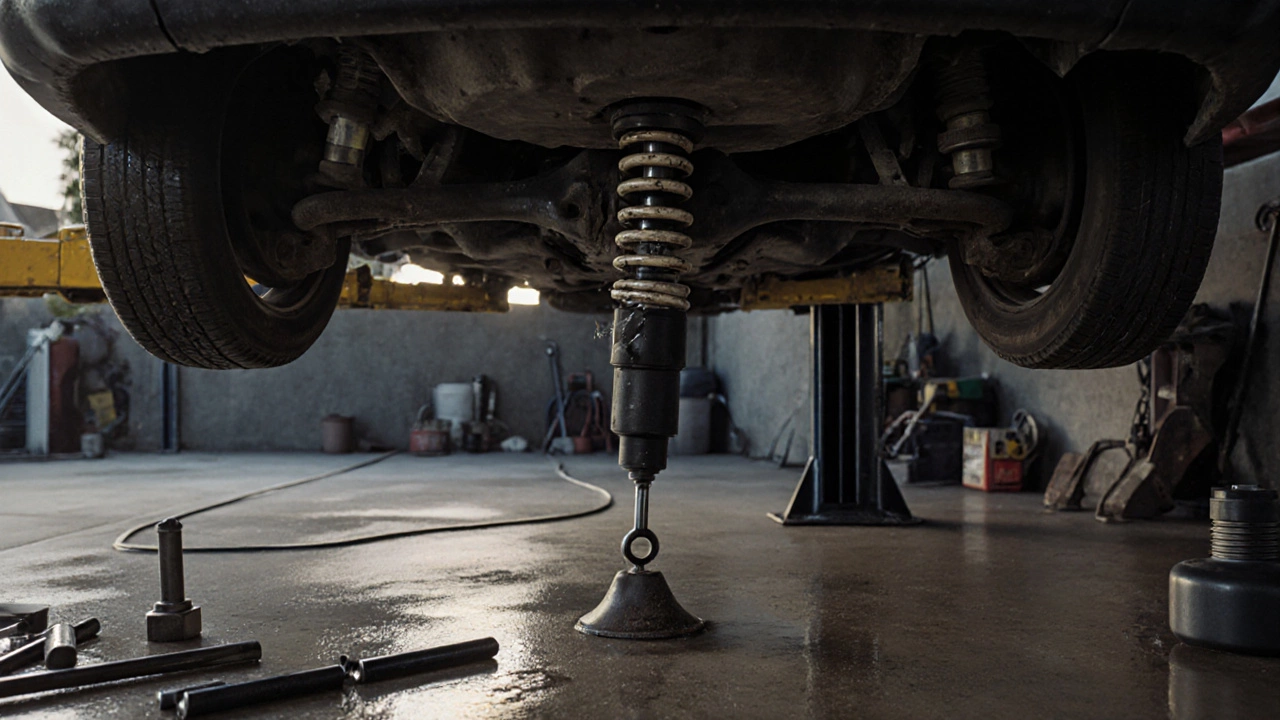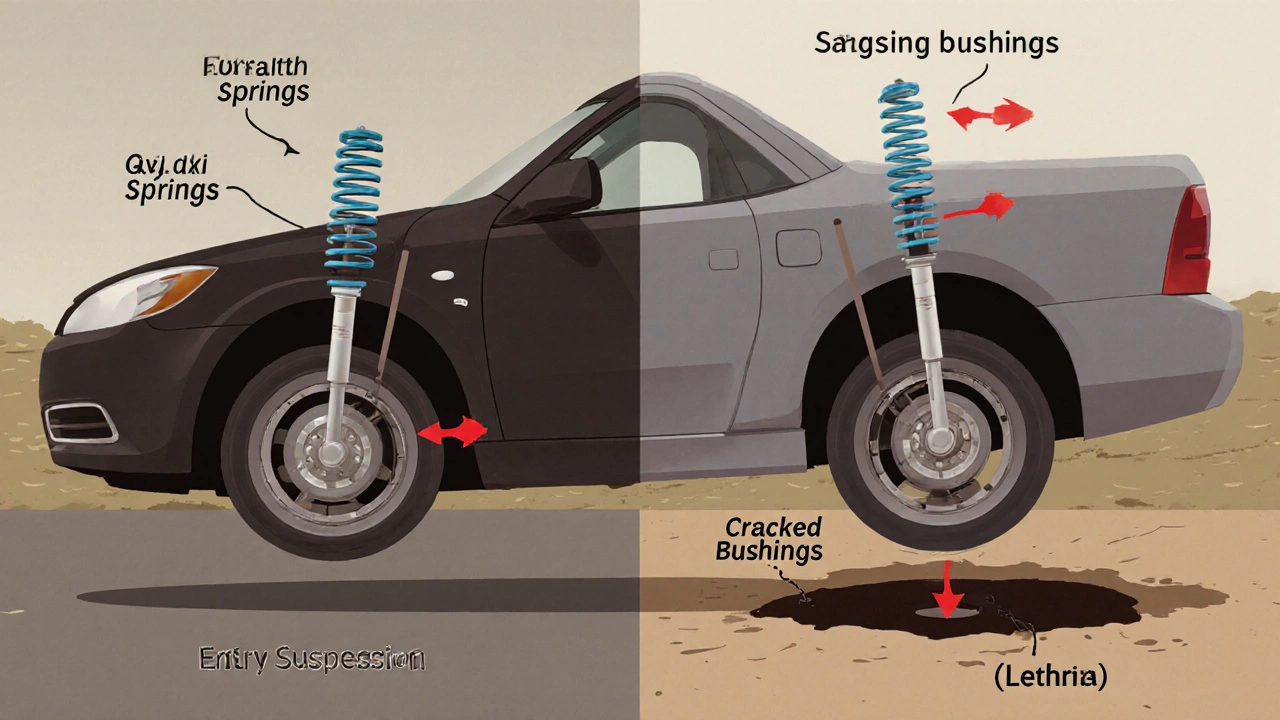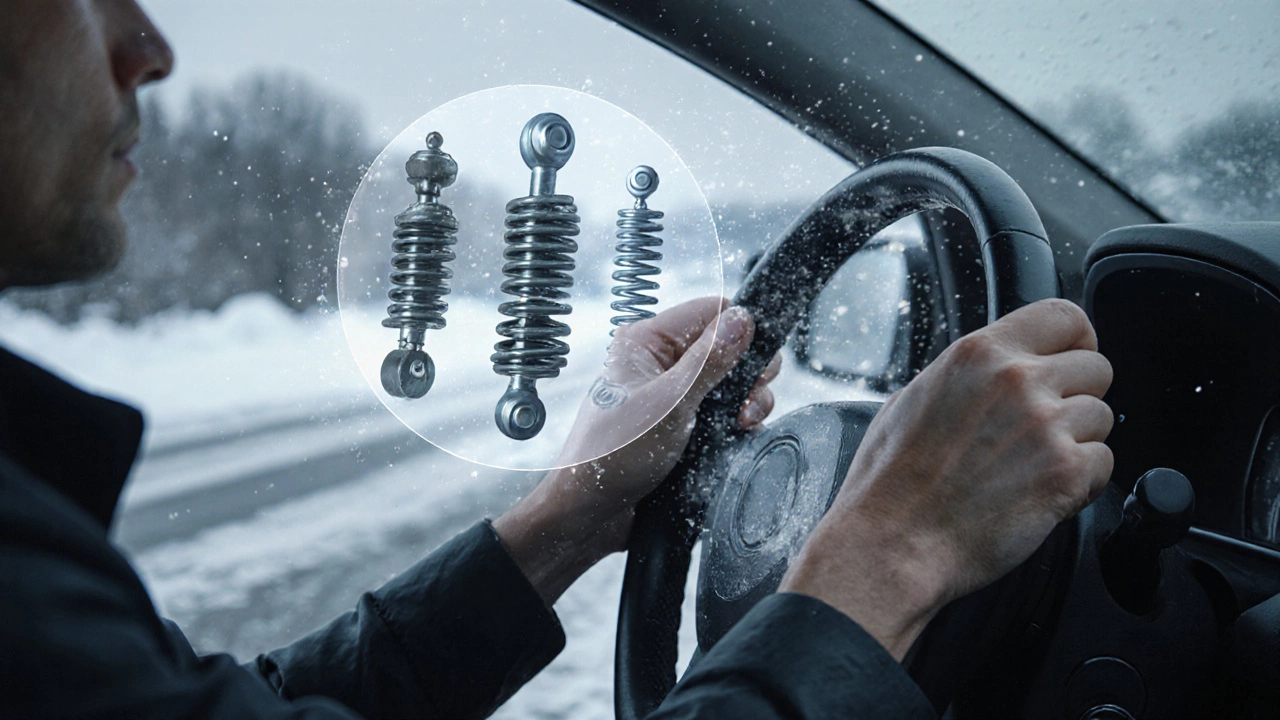 Nov, 21 2025
Nov, 21 2025
If your car feels like it’s bouncing over every bump, pulling to one side, or bottoming out on small road imperfections, your suspension is failing. A bad suspension isn’t just uncomfortable-it’s dangerous. It affects braking, steering, and tire wear. Fixing it doesn’t require a garage full of tools, but it does need the right diagnosis and a clear plan.
What causes a bad suspension?
Suspension systems are made up of shocks, struts, control arms, bushings, ball joints, and springs. Each part wears out over time. In Hamilton, where winters mean salted roads and potholes, suspension parts degrade faster than in milder climates. Most failures happen between 50,000 and 100,000 kilometers, but aggressive driving or rough roads can cut that in half.
Shocks and struts lose hydraulic fluid over time. When they do, they can’t absorb impacts properly. Bushings crack and harden, letting metal rub against metal. Ball joints get loose, causing clunks when turning. Springs sag, lowering the car and throwing off alignment. None of these are sudden failures-they creep up on you.
Signs your suspension is failing
You don’t need a mechanic to spot the warning signs. Here’s what to look for:
- Excessive bouncing: Push down hard on one corner of the car. If it bounces more than once or twice, the shock or strut is worn.
- Uneven tire wear: Cupping (scalloped dips) or one-sided wear means the tire isn’t staying flat on the road. That’s a suspension issue, not a tire problem.
- Nose dive or rear squat: When braking, the front dips too far. When accelerating, the back sinks. This happens when shocks can’t control weight transfer.
- Steering drift or pulling: If the car pulls left or right on flat roads, worn control arms or ball joints may be the cause.
- Noise: Clunking, knocking, or rattling over bumps? That’s usually a broken mount, loose joint, or cracked bushing.
These symptoms don’t always show up at once. One bad strut might make the car feel "off" for months before you realize why.
How to diagnose the problem
Start with a visual inspection. Jack up the car and check each component. Look for:
- Oil leaks on shocks or struts (wet, greasy residue)
- Cracked or crumbling rubber bushings
- Loose or rusted ball joints (wiggle the tire side-to-side-excessive movement means replacement)
- Broken or sagging springs (visible gaps between coils)
Use the bounce test again-this time, do it on each corner. If one side bounces more than the others, that side’s shock or strut is likely dead.
Check your alignment. Even if all parts look fine, worn suspension components can throw off toe and camber angles. A misaligned car wears tires fast and pulls to one side.
What parts need replacing?
Most people replace shocks and struts together-on both sides of the same axle. Replacing just one creates imbalance. Here’s what to expect:
- Shocks: Used on rear axles of most sedans and trucks. They control bounce but don’t support weight.
- Struts: Combine shock and spring in one unit. Common on front axles. They support the car’s weight and affect alignment.
- Bushings: Rubber or polyurethane sleeves that cushion movement. Replace if cracked, swollen, or squished.
- Ball joints: Connect control arms to steering knuckles. Replace if they have play or are dry.
- Control arms: Rarely fail, but if the bushings are gone and the arm is bent, replace the whole unit.
Don’t replace springs unless they’re visibly broken or sagging. Most springs last the life of the car.

Step-by-step repair guide
Replacing shocks or struts is doable with basic tools, but struts require a spring compressor. If you’re not comfortable with that, skip to the professional section.
- Buy matching parts: Get OEM or quality aftermarket parts (KYB, Monroe, Bilstein). Avoid the cheapest brands-they fail faster.
- Jack up and secure the car: Use jack stands. Never work under a car held only by a jack.
- Remove the wheel: This gives you access to the top and bottom mounts.
- Disconnect the sway bar link: Usually a bolt near the bottom of the strut or shock.
- Remove the brake line bracket (if present): Don’t pull on the brake line.
- Unbolt the top mount: Inside the trunk or under the hood, remove the nuts holding the strut to the body.
- Lower the control arm: Use a floor jack under the control arm to relieve pressure before removing the bottom bolt.
- Remove the old unit: Pull it out carefully.
- Install the new unit: Reverse the steps. Tighten all bolts to manufacturer specs-over-tightening can damage threads or bushings.
- Reinstall the wheel and lower the car: Torque lug nuts to spec.
After replacing struts or shocks, get an alignment. Even if you didn’t touch the alignment components, the new parts change the geometry slightly.
When to call a professional
Strut replacement requires a spring compressor. Renting one is risky if you’ve never used it. A compressed spring stores massive energy-if it slips, it can cause serious injury. If you’re unsure, pay for professional installation. Labor for strut replacement runs $150-$250 per axle in Ontario, but it’s worth it for safety.
Also call a pro if:
- You find bent control arms or broken mounts
- Multiple components are worn (you’ll need alignment and possibly frame inspection)
- Your car has electronic suspension (air ride, adaptive dampers)
These systems need diagnostic tools and factory-level knowledge. Guessing here can cost you more than fixing it right the first time.
How much does it cost?
Parts and labor vary by car and location. Here’s a realistic estimate for a mid-sized sedan in Southern Ontario:
| Part | Parts Only | Parts + Labor |
|---|---|---|
| Shock absorber (pair) | $120-$250 | $250-$400 |
| Strut assembly (pair) | $300-$600 | $700-$1,200 |
| Bushings (set of 4) | $80-$150 | $250-$400 |
| Ball joint (pair) | $100-$200 | $300-$500 |
| Alignment (after repair) | $80-$120 | $80-$120 |
Replacing both front struts and rear shocks on a Honda Civic or Toyota Corolla? Budget $900-$1,400 total. That includes alignment. Skip the cheap parts-$200 shocks won’t last 20,000 km.

Preventing future suspension problems
Good suspension lasts longer with smart habits:
- Avoid potholes. If you can’t steer around one, slow down before hitting it. Speed multiplies damage.
- Wash undercarriage in spring. Salt and grime eat away at bushings and joints.
- Check suspension every 20,000 km. Especially after winter.
- Don’t overload your car. Excess weight stresses springs and shocks.
- Replace worn parts in pairs. One new shock on one side creates imbalance.
Driving with bad suspension is like driving with worn brakes. You think you’re okay until you need to stop suddenly-and you can’t.
What happens if you ignore it?
Ignoring bad suspension leads to cascading damage:
- Worn tires: Uneven wear means you’ll need new tires every 15,000 km instead of 50,000.
- Brake wear: Nose dive puts extra load on front brakes, wearing pads faster.
- Steering damage: Loose ball joints can break while turning-loss of control.
- Frame damage: Constant impacts from a soft suspension can bend suspension mounts or even the chassis over time.
It’s not just expensive-it’s a safety risk. In icy conditions, a car with bad suspension won’t respond properly to steering inputs. That’s how accidents happen.
Can I drive with a bad suspension?
You can, but you shouldn’t. Driving with worn shocks or struts reduces control, increases stopping distance, and causes uneven tire wear. In wet or icy conditions, the risk of losing control rises significantly. If you notice clunking, excessive bouncing, or pulling, get it checked within a week.
How long do shocks and struts last?
Typically 50,000 to 100,000 kilometers, but this varies. In places like Hamilton with harsh winters and rough roads, they may wear out closer to 60,000 km. Aggressive driving, frequent off-road use, or hauling heavy loads cuts lifespan in half.
Should I replace shocks and struts at the same time?
Yes. Replacing only one side creates imbalance. The car will pull, handle unevenly, and wear tires faster. Always replace in pairs-front or rear, depending on what’s worn.
Do I need an alignment after replacing suspension parts?
Always. Even if you didn’t touch the alignment components, new shocks or struts change how the car sits and how the wheels contact the road. Skipping alignment leads to rapid tire wear and poor handling.
Are aftermarket parts as good as OEM?
Some are. Brands like KYB, Monroe, and Bilstein often outperform OEM parts in durability and ride quality. Avoid no-name brands sold at discount auto stores-they’re made to be cheap, not long-lasting. Look for parts with a 3-year warranty or better.
Can worn suspension cause the car to pull to one side?
Yes. Worn ball joints, control arm bushings, or misaligned struts can cause the car to drift left or right. This isn’t always a steering issue-it’s often suspension-related. Check for play in the joints and inspect bushings before assuming it’s a tire or alignment problem.
Next steps
Start with the bounce test. If it fails, inspect the shocks and struts for oil leaks. If you see any, replace them. If the car pulls or the tires are cupped, check the ball joints and bushings. Don’t wait for a loud clunk or a tire to blow. Fixing suspension early saves money, time, and risk.
Keep a record of your repairs. Note the date, parts used, and mileage. That way, you’ll know when to check again. Suspension isn’t a "set it and forget it" part-it’s a critical safety system that needs attention.